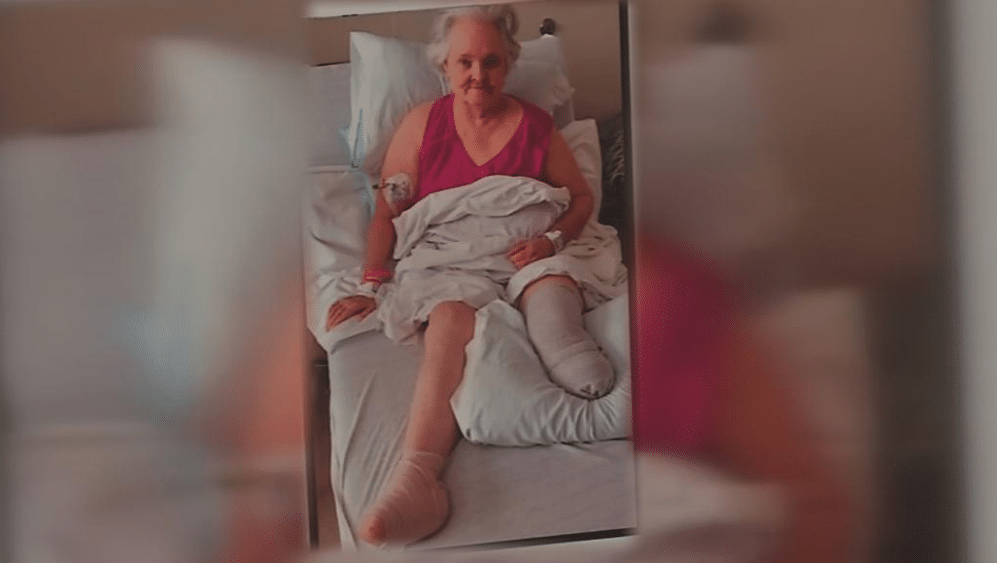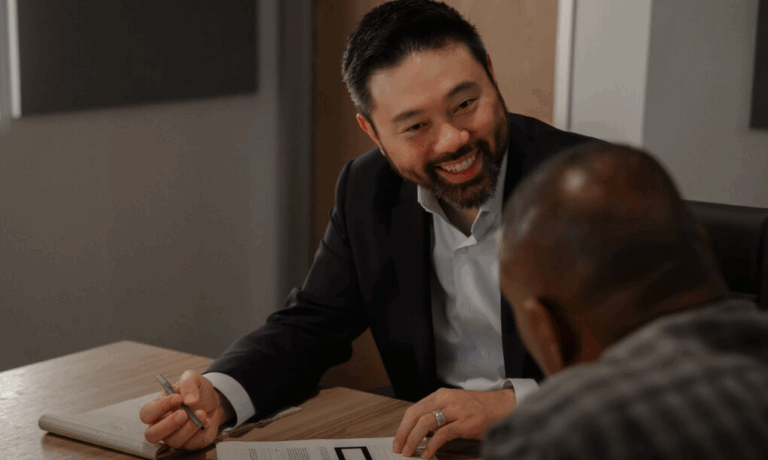Author: Shelby Benavidez
Contributing Attorney: Matthew Brunell, attorney
Most people have heard of medical malpractice, but not everyone realizes just how unusual these cases can get. Some cases don’t fit the usual mold at all. Some are stranger, slower, and far more shocking than the stereotype.
This article is part of Shocking Medical Malpractice Cases, our limited series exploring real cases that show how medical errors happen and what patients can learn from them. The case of Carolyn Boerste is a perfect example. It involves a sponge the size of a small towel, quietly moving around inside her abdomen for years, multiple chances to catch the mistake, and an ending no one (least of all Carolyn) ever saw coming.
Carolyn Boerste’s Health Background
Carolyn lived with diabetes, poor circulation, and serious vascular disease – a combination that can slowly narrow or block the arteries supplying blood to the legs. Over time, this can cause pain, weakness, and difficulty walking. In more severe cases, it can even threaten the limb itself.
By early 2011, Carolyn’s circulation had declined enough that her doctors recommended a major operation called an aortobifemoral bypass. This procedure essentially creates a new pathway for blood to travel from the aorta down into the legs, bypassing the clogged or damaged arteries. It’s a big surgery, but for someone in Carolyn’s situation, it’s often the best way to restore blood flow.
In March, she underwent the bypass at University Hospital in Louisville, hoping the procedure would help provide relief and a fresh start. Her underlying conditions made the surgery necessary, and nothing about her health suggested that what came next was even remotely possible.
The Unusual Medical Malpractice Timeline
The Initial Surgery
During big abdominal surgeries, surgeons rely on large, cloth-like laparotomy sponges to help them see and work safely. These aren’t tiny pieces of gauze – they’re hefty pads, roughly the size of a small towel, used to soak up blood, keep tissues out of the way, and give the surgical team a clear view of what they’re doing. They’re placed in and out of the body throughout the procedure, which is why careful counting is such an important part of every operation.
Throughout the operation, multiple sponges are placed inside the patient’s abdomen to soak up blood and provide visibility. To prevent sponges from being left in the body, hospitals require sponge count at several points throughout the surgery – before closing the incision, before and after breaks, and during transitions. The count should make sure that any sponges that into the body also come out.
So, at some point during Carolyn’s bypass procedure, one of these large sponges was placed deep in her abdomen. Unfortunately, testimony later revealed that the surgical team did not follow count procedures.
The “lunch count” – a required check if staff leave the room for breaks – was reportedly skipped, and other counts were rushed or treated more like suggestions. While each sponge contained an X-ray-detectable marker, no one realized one was missing at the end of the operation. By the time the incision was closed, a sponge the size of a hand towel was still inside Carolyn’s abdomen, completely unnoticed by the team.
Continued Discomfort and CT Scans
In March of 2015, four years after the surgery, Carolyn was taken to the emergency room with gastrointestinal symptoms. A CT scan revealed the sponge’s marker inside her body. The radiologist called the emergency physician and reported the sponge marker. Instead of telling Carolyn about the sponge, they diagnosed her with a urinary tract infection and sent her home.
The CT report revealing the sponge was faxed to Carolyn’s primary care physician, Dr. Kim Brumleve, at a federally subsidized clinic for low-income patients. Dr. Brumleve claimed that she assumed the ER physician had relayed the information to Carolyn already, so she didn’t bother mentioning it. The sponge stayed inside Carolyn’s abdomen for another 20 months.
Removing the Sponge and Recovery
In November 2016, Carolyn returned to the same ER with more severe gastrointestinal issues, and another CT scan once again revealed the sponge. It was finally removed later that month by exploratory laparotomy.
As if Carolyn hadn’t been through enough already, her recovery took another painful turn. Surgery alone can knock even a healthy patient off their feet, but for someone with diabetes, poor circulation, and a body already weakened by years of internal inflammation, the recovery road was steep.
Because her mobility was limited, Carolyn became bedbound for long stretches. Her medical team should have lifted her with a bed sheet to prevent pressure ulcers, but Carolyn reported they failed to do so. Pressure ulcers are deep, painful sores that form when skin and underlying tissue don’t get enough blood flow for too long. They are common in diabetic patients, especially those who also have vascular disease, but they’re extremely dangerous.
Soon, ulcers began forming on Carolyn’s heels. What started as small wounds gradually worsened, refusing to heal the way they might in someone with healthy circulation. Every day that Carolyn remained immobile, the ulcers deepened, making movement even more painful and further limiting her ability to get out of bed.
A rehabilitation center eventually stepped in to help, but even with professional care, the damage had advanced too far. The combination of her underlying vascular disease, the years of inflammation caused by the sponge, and the severity of the ulcers created a situation with no good options.
By the summer of 2017, doctors delivered the news no patient ever wants to hear: the tissue in her left leg was too compromised to save. In July, Carolyn underwent a below-the-knee amputation.
Carolyn Boerste’s MedMal Lawsuit
After years of unexplained symptoms, a delayed diagnosis, and eventually the loss of her leg, Carolyn filed a medical malpractice lawsuit against the hospital, the surgical team, and the providers who missed the warning signs. Carolyn and her team argued that a preventable mistake started a chain reaction of harm, and multiple medical professionals failed to intervene when they had the chance.
However, the defense pushed back hard. They pointed to Carolyn’s diabetes, vascular disease, and other chronic conditions, arguing that her declining health, especially her eventual amputation, was caused by her underlying medical issues, not a forgotten surgical sponge. They claimed that even if errors occurred, her comorbidities played a larger role in the outcome than anything the providers did or failed to do. Fortunately for Carolyn, the court didn’t see it that way.
How the Jury Decided Liability
The jury ultimately decided that Carolyn’s preexisting health problems didn’t excuse the errors made by the medical professionals. While the court acknowledged that her medical history made her more vulnerable, it concluded that this actually increased the responsibility of her healthcare team to act promptly and carefully.
- 60% of the liability was assigned to the hospital and nursing staff for failing to follow mandatory sponge-count policies.
- 10% was assigned to Dr. Marvin Morris for not ensuring the final count was accurate.
- 15% was assigned to the family physician and other outpatient providers who received the CT report but didn’t act on it.
In the court’s view, this was a classic example of systemic breakdown – a series of missed opportunities where each provider had a chance to prevent harm but didn’t. The judges also emphasized that leaving behind a large surgical sponge is considered a “never event”, meaning it’s so preventable that it should never occur in competent medical practice.
The Verdict and the Award
When all evidence had been presented, the jury awarded Carolyn about $10.5 million in total damages, including roughly $9.5 million in compensatory damages for medical costs, pain, suffering, and the profound impact the amputation had on her life. An additional $1 million was awarded as punitive damages, meant to penalize what the jury viewed as reckless and blatant disregard for patient safety.
In January 2022, the Kentucky Court of Appeals reviewed the case. While the judges upheld the full compensatory award, they vacated the $1 million punitive damages portion. The reason wasn’t that the hospital’s conduct was acceptable, but that the jury instructions for punitive damages weren’t worded correctly, making that part of the verdict legally unsound.
Why The Carolyn Boerste Medical Malpractice Case Still Matters Today
1. The Size of the Foreign Object
In many retained-object cases, the item left behind is something small, like a piece of gauze or a broken surgical instrument tip. However, Carolyn’s case involved an 18″ × 18″ laparotomy sponge. That’s not something that slips through the cracks unnoticed. The fact that such a large object could be overlooked shows how even “routine” safety steps can break down if policies aren’t taken seriously.
If hospitals can miss something this big, patients should know that oversight is possible even in major institutions. It highlights why advocate involvement, questions, and second opinions can be important in personal healthcare.
2. Long Delays
The sponge wasn’t discovered or removed until five years after the surgery. Five years! During that time, it floated around inside her abdomen, causing inflammation, pain, and confusion for multiple healthcare providers who couldn’t pinpoint what was wrong.
Medical errors don’t always show up right away. Some injuries progress slowly and quietly. Carolyn’s case reminds us that persistent, unexplained symptoms shouldn’t be ignored, and that patients shouldn’t be dismissed just because an issue doesn’t fit a neat diagnostic box.
3. Multiple Acts of Negligence
What happened to Carolyn was a chain reaction involving a failed sponge count in the operating room, a radiology report that clearly mentioned a retained sponge, outpatient providers who didn’t act on that report, and rehab care issues that worsened her mobility and pressure ulcers.
Most medical malpractice cases don’t hinge on a single dramatic moment. They grow out of systemic breakdowns and miscommunication. Carolyn’s story is a perfect example of how patient safety relies on every link in the chain.
4. Worsening Conditions
On paper, a “retained sponge” might sound like a simple fix: find it, remove it, move on. However, the negligence of Carolyn’s doctors led to years of inflammation, infections, poor mobility, and worsening vascular disease eventually led to a below-the-knee amputation.
A lot of people hear “medical malpractice” and think of petty complaints or exaggerated lawsuits. However, in Carolyn’s case, one overlooked step in her surgery set off a chain of problems that changed nearly every part of her life. What might look like a small slip on paper can have serious, long-term consequences for the person living with it.
5. The Verdict
The truth is, winning a medical malpractice case isn’t easy. Many cases never make it to trial, and even fewer end with a significant verdict, but Carolyn’s case shows that when the failures are serious, preventable, and well-documented, patients can win.
The jury awarded around $10.5 million, including roughly $9.5 million in compensatory damages and $1 million in punitive damages aimed at the hospital and nursing staff. When hospitals ignore policies, when communication breaks down, or when “never events” are treated like no big deal, juries take notice. These outcomes push healthcare institutions to improve their systems, retrain staff, enforce safety protocols, and adopt better checks to prevent similar disasters from happening to someone else.
The Carolyn Boerste Medical Malpractice Lawsuit: Lessons for Patients & Caregivers
Carolyn’s story is a reminder that medical malpractice isn’t always dramatic or instantly recognizable. Sometimes the harm is subtle, hiding behind lingering symptoms or unexplained pain. In her case, a large surgical sponge was left inside her abdomen and remained undiscovered for five years, long enough to cause chronic inflammation, complications, and ultimately the loss of her leg. It’s an outcome that feels almost unbelievable, yet it happened to a real patient simply hoping to recover from surgery.
One of the biggest lessons from Carolyn’s experience is the importance of asking questions. Even when you trust your doctor or hospital, it’s okay to speak up. If you undergo imaging, ask for the results and what they mean. In Carolyn’s situation, the sponge marker actually appeared on a CT report, but no one ever told her for nearly two years. Clear communication can make all the difference in catching mistakes early.
While underlying conditions can complicate recovery, they don’t excuse preventable mistakes. The defense argued that Carolyn’s diabetes and vascular disease were responsible for her decline. The court disagreed, reinforcing that vulnerable patients deserve more caution, not less.
Finally, remember that you don’t have to navigate concerns like these alone. If something feels wrong in your recovery, trust your instincts. Seek a second opinion and consider speaking with a qualified malpractice attorney. They can help you determine if you have a valid case and guide you on your next steps.




